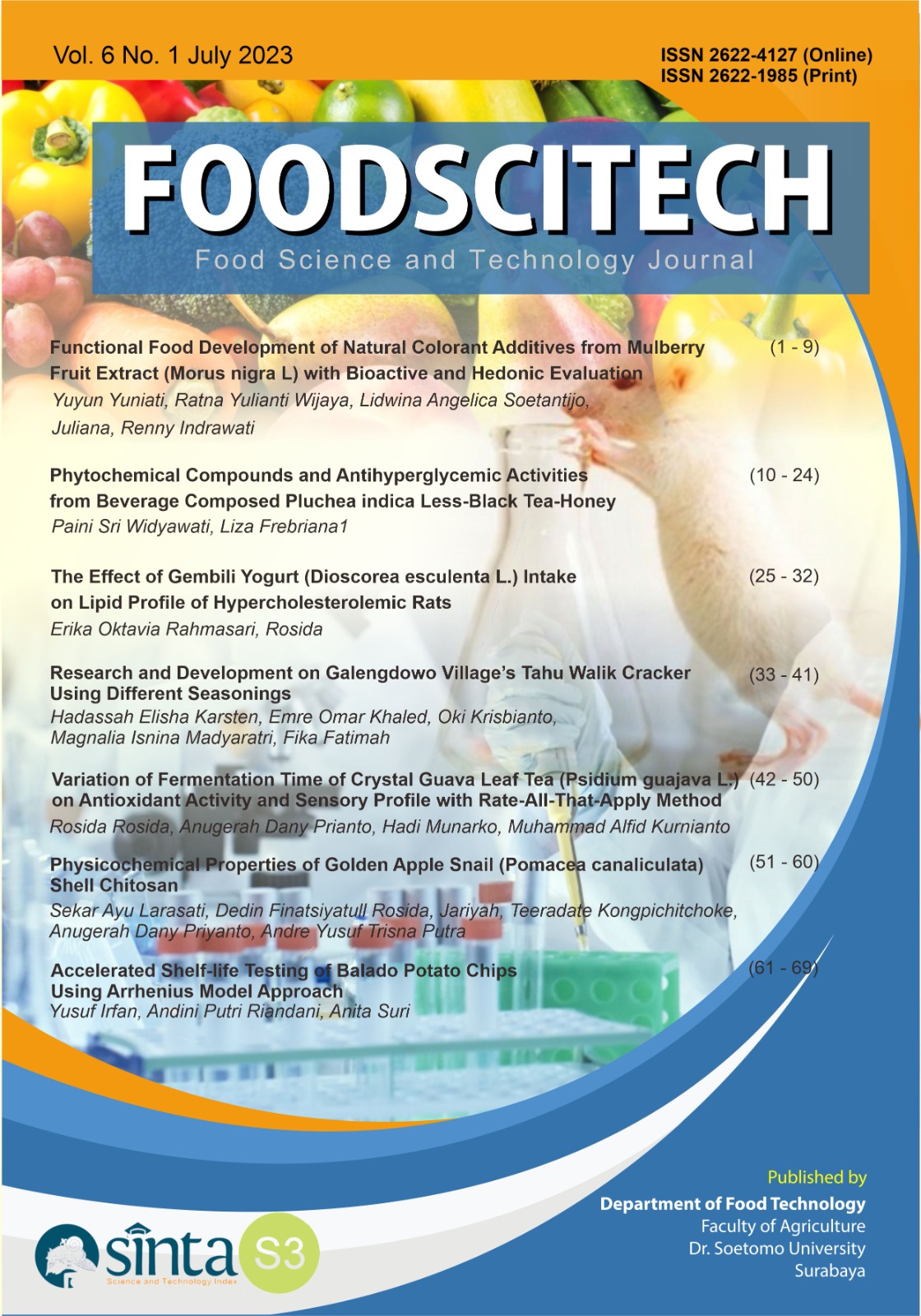Main Article Content
Abstract
All modern lifestyles such as unhealthy eating patterns and lack of exercise can trigger the accumulation of free radicals in the human body, where the human body cannot neutralize these free radicals fast enough because of the large number of free radicals that have accumulated in it. Therefore, antioxidant compounds need to be consumed to suppress free radicals. In this study, mulberry is promoted as a natural, functional, and dye source that has been explored for further applications in food and beverages. This research aims to develop natural coloring products from mulberry fruit through extraction and encapsulation processes. Furthermore, hedonic testing was also carried out to determine the panelist's preference level for jelly products using mulberry fruit dyes. Mulberry fruit is extracted, encapsulated by freeze drying method, and processed into a natural dye in jelly products. Mulberry fruit extract contains vitamin C 4.1 g/ml, anthocyanin content of 215.16 mg/L, and antioxidant activity of 73.25. Mulberry encapsulates can be used as a natural dye in jelly products. Based on hedonic testing, jelly products made from natural dyes have superior taste and texture. Further development of natural mulberry fruit encapsulated dyes needs to be done to increase solubility, color sharpness, aroma and color stability
Keywords
Article Details

This work is licensed under a Creative Commons Attribution-NonCommercial-ShareAlike 4.0 International License.

This work is licensed under a Creative Commons Attribution-ShareAlike 4.0 International License.
References
- Ali, M., Durrani, Y., & Ayub, M. (2016). Effect of Drying Techniques and Storage on Mulberry (Morus alba) Quality. Sarhad Journal of Agriculture, 32(2), 80–88. https://doi.org/10.17582/journal.sja/2016/32.2.80.88
- Arya, S. P., Mahajan, M., & Jain, P. (2000). Non-spectrophotometric methods for the determination of Vitamin C. Analytica Chimica Acta, 417(1), 1–14. https://doi.org/10.1016/S0003-2670(00)00909-0
- Chaudhary, S., & Singh, N. (2019). Organoleptic Evaluation of Product by Using Natural Color in Food Product ( Cookies ). 8(10), 93–97.
- Cheng, P., Zhao, X., El-Ramady, H., Elsakhawy, T., Waigi, M. G., & Ling, W. (2022). Formation of environmentally persistent free radicals from photodegradation of triclosan by metal oxides/silica suspensions and particles. Chemosphere, 290(133322.).
- Cruz-Molina, A. V. D. La, Ayala Zavala, J. F., Bernal Mercado, A. T., Cruz Valenzuela, M. R., González-Aguilar, G. A., Lizardi-Mendoza, J., Brown-Bojorquez, F., & Silva-Espinoza, B. A. (2021). Maltodextrin encapsulation improves thermal and pH stability of green tea extract catechins. Journal of Food Processing and Preservation, 45(9), 1–13. https://doi.org/10.1111/jfpp.15729
- Elsayed Azab, A., A Adwas, Almokhtar, Ibrahim Elsayed, A. S., A Adwas, A., Ibrahim Elsayed, Ata Sedik, & Quwaydir, F. A. (2019). Oxidative stress and antioxidant mechanisms in human body. Journal of Applied Biotechnology & Bioengineering, 6(1), 43–47. https://doi.org/10.15406/jabb.2019.06.00173
- Hajam, Y. A., Rani, R., Ganie, S. Y., Sheikh, T. A., Javaid, D., Qadri, S. S., Pramodh, S., Alsulimani, A., Alkhanani, M. F., Harakeh, S., Hussain, A., Haque, S., & Reshi, M. S. (2022). Oxidative Stress in Human Pathology and Aging: Molecular Mechanisms and Perspectives. Cells, 11(3). https://doi.org/10.3390/cells11030552
- Indrawati, R., Lukitasari, D. M., Yuniati, Y., Heriyanto, & Limantara, L. (2017). Encapsulation, Properties, and Thermal Study of Red Biocolorant from Selected Plants Obtained Through Physical Extraction. International Journal of Chemical Engineering and Applications, 8(6), 371–376. https://doi.org/10.18178/ijcea.2017.8.6.686
- Kim, B. K., Park, K. J., Lim, J. H., & Jeong, J. W. (2009). Antioxidant activities of mulberry (Morus alba L.) leaf extracted with different concentrations of EtOH. Food Science and Biotechnology, 18(6), 1476–1480.
- Lee, K., Hyun, J., & Lee, Y. (2022). Why do and why Don’t people consume fast Food?: An application of the consumption value model. Food Quality and Preference, 99(104550).
- Martemucci, G., Costagliola, C., Mariano, M., D’andrea, L., Napolitano, P., & D’Alessandro, A. G. (2022). Free Radical Properties, Source and Targets, Antioxidant Consumption and Health. Oxygen, 2(2), 48–78.
- Mattioli, R., Francioso, A., Mosca, L., & Silva, P. (2020). Anthocyanins: A Comprehensive Review of Their Chemical Properties and Health Effects on Cardiovascular and Neurodegenerative Diseases. Molecules, 25(17). https://doi.org/10.3390/molecules25173809
- Mohamad, M. F., Dailin, D. J., Gomaa, S. E., Nurjayadi, M., & El Enshasy, H. (2019). Natural colorant for food: Alternative a healthy. International Journal of Scientific and Technology Research, 8(11), 3161–3166.
- Nafiunisa, A., Aryanti, N., Wardhani, D. H., & Kumoro, A. C. (2017). Microencapsulation of Natural Anthocyanin from Purple Rosella Calyces by Freeze Drying. Journal of Physics: Conference Series, 909(1). https://doi.org/10.1088/1742-6596/909/1/012084
- Nuratika, E., Aseny, N., Syamsuardi, N., & Fitmawati, F. (2020). Clarification of sumatran mulberry (Morus macroura var. macroura, Moraceae) from West Sumatra, Indonesia using nucleus ribosomal its (Internal Transcribed Spacer) gene. Indian Journal Of Agricultural Research, 54, 635–640.
- Pandit, G., Kharkar, M., Gokhale, C., & Rawool, A. (2020). Development of Watermelon (Citrullus lanatus) Rind Spaghetti with Agar Agar–A Preliminary Study. Progress in Applied Science and Technology, 10(1), 261–268.
- Paula Neto, H. A., Ausina, P., Gomez, L. S., Leandro, J. G., Zancan, P., & Sola-Penna, M. (2017). Effects of Food Additives on Immune Cells As Contributors to Body Weight Gain and Immune-Mediated Metabolic Dysregulation. Front Immunol, 8(1478).
- Roy, S., & Rhim, J. W. (2020). Anthocyanin food colorant and its application in pH-responsive color change indicator films. Critical Reviews in Food Science and Nutrition, 0(0), 1–29. https://doi.org/10.1080/10408398.2020.1776211
- Saensouk, S., Senavongse, R., Papayrata, C., & Chumroenphat, T. (2022). Evaluation of Color, Phytochemical Compounds and Antioxidant Activities of Mulberry Fruit (Morus alba L.) during Ripening. Horticulturae, 8(12). https://doi.org/10.3390/horticulturae8121146
- Wahyuningsih, S., Wulandari, L., Wartono, M. W., Munawaroh, H., & Ramelan, A. H. (2017). The Effect of pH and Color Stability of Anthocyanin on Food Colorant. IOP Conference Series: Materials Science and Engineering, 193(1). https://doi.org/10.1088/1757-899X/193/1/012047
- Wen, P., Hu, T. G., Linhardt, R. J., Liao, S. T., Wu, H., & Zou, Y. X. (2019). Mulberry: A review of bioactive compounds and advanced processing technology. Trends in Food Science & Technology, 83, 138–158.
- Yuniati, Y., Elim, P. E., Alfanaar, R., Kusuma, H. S., & Mahfud. (2021). Extraction of anthocyanin pigment from hibiscus sabdariffa l. By ultrasonic-assisted extraction. IOP Conference Series: Materials Science and Engineering, 1010(1). https://doi.org/10.1088/1757-899X/1010/1/012032
